Tags
Lamphun is a quaint Northern Thailand town about 30 minutes south of Chiang Mai. Not exactly off the beaten path, but then I don’t expect it gets all that many visitors either. The drive from Chiang Mai along old Highway 106 is a destination in itself with much of the road to Lamphun lined with lofty hundred foot tall yang-na trees decorated with saffron colored sashes. The town itself, founded six centuries before Chiang Mai and about 1000 years before Bangkok became the capital of Thailand, is probably what Chiang Mai looked liked twenty years ago.
Out of all the times I’d been to Chiang Mai, I’d never heard of Lamphun. Most touri have not. There’s more than enough in and around Chiang Mai to keep your days full. And since most of those activities involve an admission fee – and a kick back to whoever delivered you there – the relatively cheap trip to Lamphun doesn’t get a lot of play. Though it should. On my first visit I only was able to spend time at two and a half wats in Lamphun. I’m looking forward to returning and spending a good deal more time on my next visit.
My initial visit was thanks to a hungry private car driver trolling for a fare who’d accosted me one late morning while I was sipping coffee at the Starbucks on Chan Klan Road in downtown Chiang Mai. I’d challenged him to come up with a place to visit that’d I’d not been to before, and after running through the usual touri activities he’d hit upon the road to Lamphun and was rewarded with a fare for the day. With no advance plans of visiting the town I hadn’t a clue as to what to see or do. It was all in my driver, Mr. Ot’s, hands.
The ride out to see the trees was the initial focus of our journey, the wats an add-on since we were already there. Neither Mr. Ot’s English nor my Thai was good enough to identify the wats I visited; I had to rely on Google after the trip was over and I was back in my hotel room. The first wat we visited turned out to be quite famous and is considered to be one of the most revered pilgrimage sites in the entire country. The second, in the majority of on-line references by touri, was incorrectly identified as it’s more well-known brother. Or just plain misidentified. I don’t think Lamphun has a Tourist Board. If they do, then somebody’s brother or cousin is making a good salary for doing absolutely no work. Not a big surprise in Thailand.
Since my trip I’ve discovered there actually is quite a lot to do and see in Lamphun and the surrounding area. For my first visit, though, the wats were enough. And worth the trip on their own. Like Chiang Mai, Lamphun has a series of brick-lined moats filled with lotus blossoming in the muck running through it (or maybe that’s around it) and we followed along the banks of one, down a small shady street to Wat Phra That Hariphunchai, Lamphun’s most famous wat.
The wat’s small parking lot was bustling with activity, lots of locals running about, a few floats still in the process of being decorated for a parade in town that night, and the detritus of a motorcade accompanied by numerous military vehicles filled the tiny area but managed to maintain a clear path to the ticket booth where anyone who is not Thai pays a 20 baht admission fee. From the look of the crowd inside, the wat’s monks were going to have a difficult time deciding on how best to spend the 20 baht haul they’d made that day; the only white face to be seen was mine.
Built in the 1100s, Wat Phra That Hariphunchai’s wiharn is front and center after passing through its brick arch entrance gate flanked by a pair of large stone guardian lions. On my visit, a military delegation had come calling to pay respect to the wat and it’s head monk. Like with armies the world over, those of rank no longer looked capable of making it through boot camp, but the platoon of young aides scurrying about were all little hotties and looked adorable in their gleaming white uniforms. Thais seem to have a fondness for uniforms. I’m sure they think they look quite impressive decked out in military gear. I doubt they realize how cute they look, all lined up like little toy soldiers.
A humongous bronze gong, believed to be the largest in the world, sits in a place of honor centered in the paved courtyard running along the right side of the wiharn. Behind the, temple the wat’s magnificent gold chedi, which contains a hair of the Lord Buddha, glistens in the afternoon sun competing for attention with a massive nine tiered umbrella made of gold that weighs in at almost 6500 grams reminiscent of the one at Doi Suthep, the popular hill top wat in Chiang Mai which was modelled on Lamphun’s Wat Phra That Hariphunchai.
Further back are a series of smaller temples and chedis, one a crumbling brick worked edifice that must date back to the wat’s origin. A small temple nestled alongside a grassy square is chock full of Buddha statues, leaving but a small area at its entrance for visitors to gawk and worshipers to pray. The Buddha statues inside are made of a variety of materials, some quite ancient, others of a more familiar style and look to frequent visitors to Thailand’s wats. One, sitting next to a window to take advantage of the sun’s rays, was made of a translucent emerald green material, possibly glass, more likely some form of plastic. I’d not previously seen a Buddha made of this substance and it glowed from within setting off the statue’s jeweled adorned headdress.
Outside a gaggle of novice monks gathered to play with their cell phones show reverence to their religion’s god, while a lone vendor lackadaisically selling caged birds to set free huddled in the shade of the wat’s teak wood library that houses palm-leaf manuscripts from the Pali period. Scattered throughout the wat are numerous small statutes of roosters, Wat Phra That Hariphunchai being the designated Temple for people born under that sign to make a pilgrimage to.
The wat was a great find, an unexpected treasure thanks to Mr. Ot’s campaign to make a buck. After spending more than an hour touring inside I went back out to the parking lot to find my ride, temporarily waylaid by a 50 foot long reclining Buddha statue that seemed to be built as an after thought, being located outside the wat’s compound and buried alongside its parking lot.
Seeing that he’d done well in taking me to Wat Phra That Hariphunchai, Mr. Ot decided we needed to visit one more wat before calling it a day and we headed through Lamphun’s bustling streets to Wat Chamthewi or Wat Ku Kut, or Wat Whatchyamacallit as I dubbed the temple since there seems to be so much confusion over its name.
A smaller, and much more sleepy temple, Wat Chamthewi, dating back to the late 1200s, is located on the outskirts of town. While its temple is quite magnificent, its true claim to fame is the ancient square pagoda containing the ashes of Queen Chamathewi, who ruled the province during the late 9th century. Seventy feet tall,, the Mon styled chedi reaches skyward with five levels of arches comprising little chedis in the corners and a total of sixty Buddha statues, each in the position of giving out blessings.
The second most important temple in the province, Wat Chamthewi’s chedi’s spire was destroyed in a lighting strike, hence its more common name, Wat Ku Kut, or the Pagoda without top. Inside the temple, lines of massive columns adorned in gold leaf and blue glass tiles that echo the temple’s exterior upper facade stretch the length of the building. At the base of many of the pillars, small Buddha statues sit, several made of the same translucent green material I’d first encountered at Wat Phra That Hariphunchai earlier in the day. This time around, the luminescent green Buddhas were joined by several shimmering in a buttery gold color. I was quite fascinated by these images, it took very little light to bring out their beauty, which adds such a godlike reverence to the Buddha I’m surprised I haven’t run across more statues built like these in Thailand.
The half a wat we visited was more a statue situated next to one of the town’s main roads. And the visit was more of a quick pull over to the curb before zooming off again. I guess the stop was mostly Mr. Ot making sure I’d felt I got my money’s worth. It wasn’t the statue of Queen Chamathewi that I found mentioned on the internet, and really wasn’t even worth pulling over to the curb for.
Leaving town we passed a few more small temples and a few more floats being readied for the parade. I asked Mr. Ot about the festivities but he didn’t have a clue, or possibly did but did not want to take a chance that I’d make him spend an additional few hours waiting for the celebration to begin.
If you’ve visited Chiang Mai enough times to have seen the majority of the wats there and are looking for a daytime outing, consider a trip out to Lamphun. You’ll enjoy the ride and if enough visitors make it a stop on their holiday the brother or cousin of somebody in power who is responsible for tourism in Lamphun might get a raise.
Related Posts You Might Enjoy:


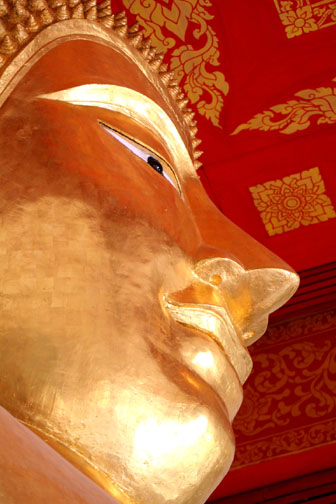
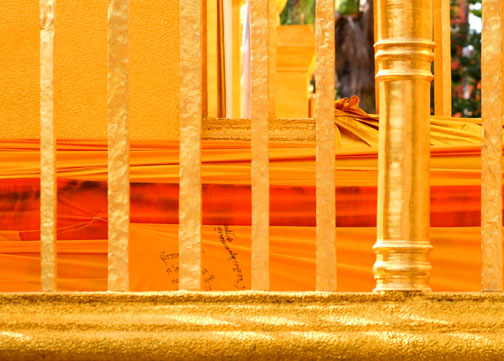
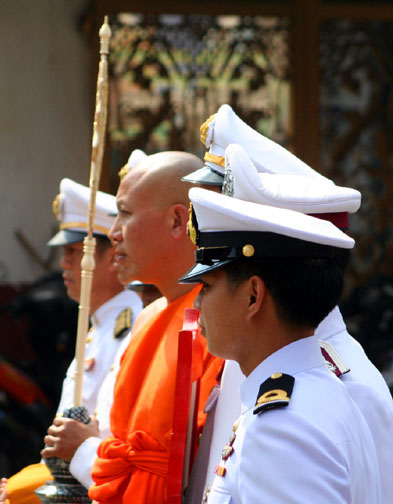
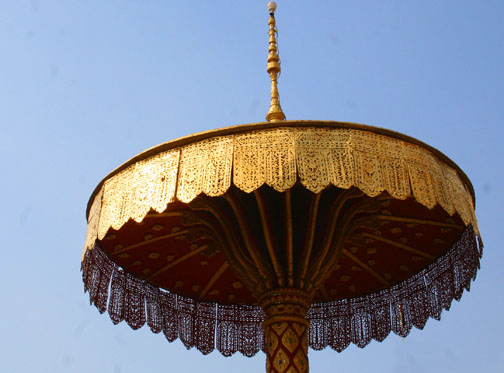
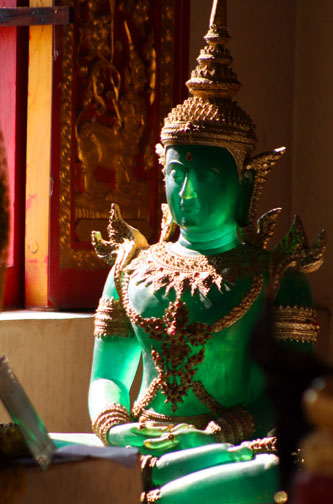





I did day trips to Lamphun and Lampang on my first trip to Thailand.
Isn’t that “translucent green Buddha” yet another replica of the Emerald Buddha? I think the original spent some time in Lamphun before it was stolen by some invading army or other.
Thanks Glenn. The Emerald Buddha (in Bangkok) is made of jasper, a type of rock. And yeah, I’d have to go Google it, but I seem to remember it had an interesting story behind it’s trip to the Big Mango. I’ve not a clue to what the ones I saw in Lamphun were made from but they reminded me of some tacky little pastic ones I’ve seen for sale by the Grand Palace. Maybe someone who knows will weigh in . . .